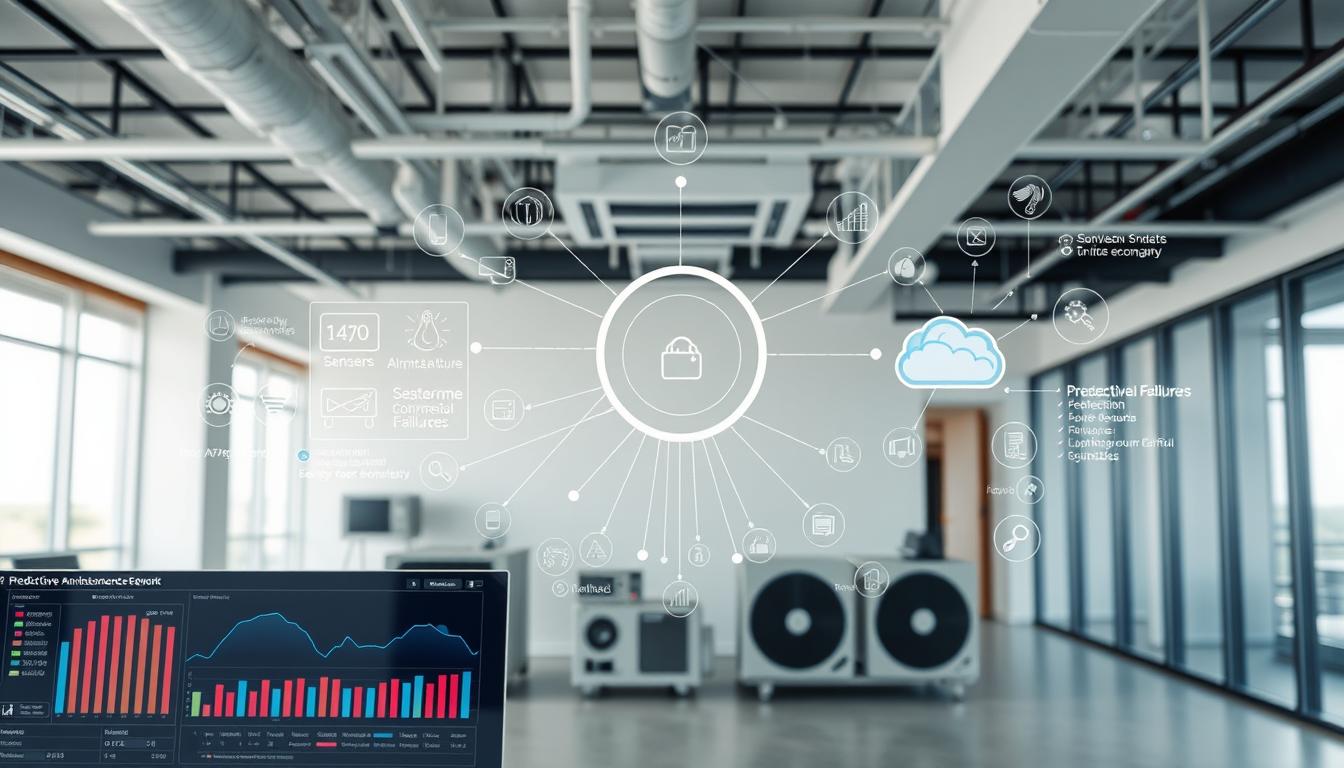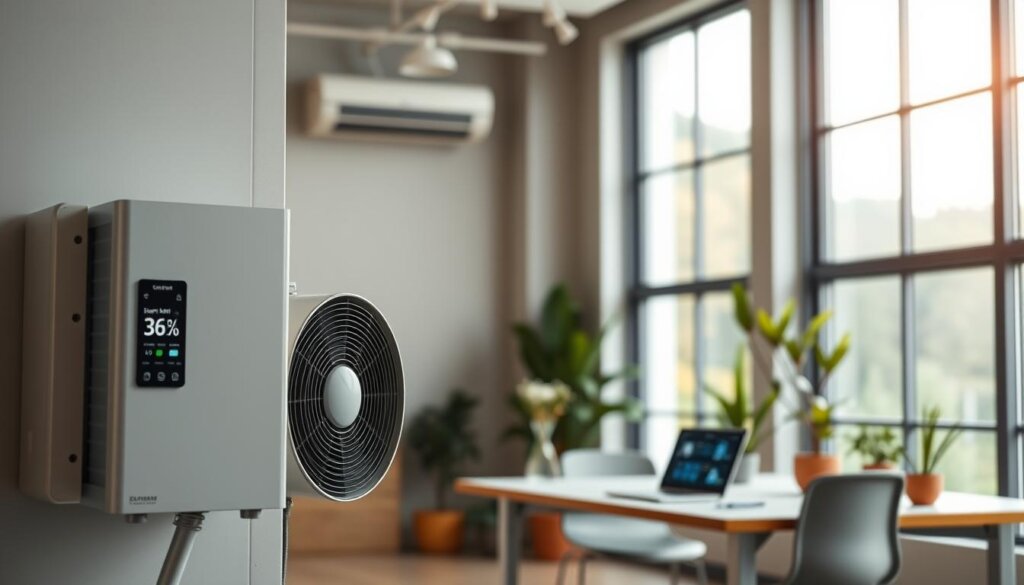Last summer, Mike, a contractor in Dallas, faced a nightmare scenario. A client’s aging commercial cooling system suddenly failed during a record heatwave. Emergency repairs cost thousands—and the customer nearly switched providers. But today, Mike’s team catches problems before they escalate. How? By using smart devices that monitor equipment health in real time.
Stories like Mike’s are becoming common. The global market for intelligent climate control solutions is booming, projected to hit $28.3 billion by 2025. Forward-thinking contractors now prioritize preventing breakdowns over scrambling to fix them. This shift saves money, builds trust, and unlocks growth.
Modern tools analyze data from connected devices, flagging issues like refrigerant leaks or motor wear. This approach reduces unnecessary service visits by up to 40%—a game-changer for businesses balancing tight margins and customer expectations. Best of all, these networks aren’t just for large corporations. With the right strategy, even small firms can compete.

Key Takeaways
- The smart climate control market is growing rapidly, creating opportunities for early adopters
- Real-time monitoring helps contractors address issues before customers notice problems
- Predictive maintenance reduces costs by minimizing emergency repairs and truck rolls
- Data-driven insights enable customized service plans that boost client retention
- Implementation requires strategic planning but delivers long-term competitive advantages
Understanding IoT Sensors for HVAC
Imagine a world where heating and cooling systems automatically adjust to weather changes and warn technicians about potential issues. This isn’t science fiction—it’s the reality shaped by internet-connected devices. By 2020, the number of these smart tools skyrocketed from 2 billion to 200 billion globally, according to Intel research. Climate control professionals now leverage this tech to transform reactive repairs into proactive solutions.
Defining Connected Systems in Climate Management
The internet of things (IoT) creates a digital nervous system for buildings. In climate control, it links devices like thermostats and airflow monitors through wireless networks. These tools track everything from room humidity to compressor vibrations, sending instant alerts when values drift from normal ranges.
Modern Applications in Temperature Regulation
Today’s advanced setups do more than just collect data. They integrate with smartphones and cloud platforms, letting technicians diagnose issues from miles away. One contractor in Phoenix reduced after-hours callouts by 35% using remote diagnostics. The best systems even sync with lighting and security tools, creating buildings that adapt to occupancy patterns.
Real-time visibility into equipment performance changes how teams work. Instead of guessing when filters need changing, the technology provides exact timelines based on airflow resistance. This precision helps businesses slash energy waste while keeping customers comfortable.
Benefits of IoT-Enabled HVAC Solutions
Contractors who upgrade to connected climate tech often discover surprising advantages. These tools don’t just fix problems—they prevent them while cutting costs and boosting customer loyalty.

Predictive Care Beats Reactive Repairs
Traditional maintenance schedules often waste time checking healthy equipment. Modern systems analyze real-time data to spot trouble early. A Chicago contractor reduced after-hours calls by 42% using vibration alerts from connected devices.
Slashing Energy Bills Automatically
Smart climate tech adjusts output based on occupancy and weather. One office building in Miami saved 18% on cooling costs last summer. The system learned usage patterns and optimized airflow without human input.
Total Visibility, Better Decisions
Interactive dashboards show equipment status across multiple locations. Managers can prioritize tasks based on actual needs rather than guesses. This precision helps teams complete 30% more preventive jobs monthly.
These innovations create win-win scenarios. Clients enjoy reliable comfort while contractors build trust through proactive service. The result? Longer equipment lifecycles and service contracts that renew automatically.
Predictive Maintenance Strategies for HVAC Systems
A hotel manager in Phoenix nearly lost a major client last spring when scheduled inspections missed failing rooftop units. Traditional approaches often leave technicians guessing—either wasting time on healthy equipment or missing looming failures. Modern strategies use live performance insights to eliminate this gamble.
Real-Time Condition Monitoring
Continuous tracking of critical parameters transforms how teams work. Vibration spikes in compressors or unusual temperature swings now trigger instant alerts. Advanced analytics spot patterns humans might overlook, like gradual pressure drops signaling refrigerant leaks. This visibility lets technicians address issues during routine visits instead of scrambling during emergencies.
Scheduled Versus Condition-Based Maintenance
Time-based checkups often result in unnecessary part replacements or missed warning signs. Data-driven approaches flip this model. One Atlanta contractor reduced after-hours calls by 38% by servicing units only when airflow metrics dipped below thresholds. Cloud platforms automatically generate work orders when readings cross predefined limits, ensuring timely responses without manual oversight.
Historical performance trends help refine strategies over time. Teams can compare maintenance outcomes against equipment lifespan data, optimizing both repair schedules and budget planning. This precision builds client confidence while cutting energy waste from overworked systems.
Remote Monitoring and Data Management
A shopping mall in Houston avoided $120,000 in repair costs last winter when unusual pressure readings flagged a hidden piping issue. This win came from live equipment tracking—a capability reshaping how teams handle climate systems. Modern tools now turn raw numbers into actionable insights, letting technicians act before small glitches become disasters.

Leveraging Real-Time Sensor Data
Connected devices stream performance metrics 24/7, from humidity levels to motor vibrations. When values drift beyond safe ranges, alerts ping technicians’ phones instantly. One contractor in Denver slashed response times by 53% using these notifications to dispatch crews during off-peak hours.
Centralized dashboards display information across multiple locations. Managers spot trends like rising energy use in specific zones, then adjust settings remotely. This visibility helps teams prioritize tasks based on actual needs rather than fixed schedules.
Cloud-Based Control and Diagnostics
Advanced software analyzes historical patterns to predict component failures. A Chicago school district extended equipment lifespan by 22% using these forecasts to replace parts before breakdowns. Cloud platforms also auto-generate compliance reports, saving hours of manual paperwork each week.
Field technicians access repair histories and diagnostic tools through mobile apps. During visits, they compare live readings to baseline data, pinpointing issues faster. Remote experts can even guide onsite crews through complex fixes via video calls, reducing repeat service trips.
Enhancing Energy Efficiency with Smart HVAC Technology
Businesses nationwide are discovering how intelligent climate solutions slash utility bills while keeping spaces comfortable. Modern systems combine live weather data, occupancy tracking, and machine learning to optimize energy use without compromising air quality or temperature control.
Optimizing Energy Consumption
Smart climate technology automatically adjusts settings based on room usage and outdoor conditions. A Seattle school district reduced energy consumption by 27% last year using motion detectors that activate cooling only when classrooms are occupied.
Zone-based controls prevent wasted power in empty areas. Office buildings now direct air flow precisely where workers are present, maintaining perfect temperature balance. Real-time dashboards help managers spot inefficiencies like overcooled storage rooms or overworked units.
Integration with Smart Grid Technology
Advanced systems sync with utility providers during peak pricing periods. When electricity costs spike, they precool spaces using cheaper off-peak power. This strategy helped a Las Vegas casino cut cooling expenses by 19% during summer heatwaves.
Machine learning analyzes historical patterns to anticipate temperature needs. Algorithms adjust outputs before weather changes hit, preventing energy spikes. Combined with automated maintenance alerts, these features keep systems running at peak efficiency year-round.
Regulatory Compliance and Automated Reporting
Meeting regulatory standards used to mean stacks of paperwork and frantic last-minute checks. Today’s climate control professionals breathe easier thanks to intelligent tools that handle compliance automatically. These solutions track every aspect of system performance while generating audit-ready documentation.
Connected devices monitor air quality and equipment operations 24/7. They compare real-time data against local and federal requirements, flagging deviations instantly. A school district in Ohio reduced compliance errors by 83% using this approach—no more missed inspections or manual record-keeping.
Modern platforms create detailed reports showing how building systems meet energy efficiency standards. Facility managers receive alerts when CO2 levels or humidity drifts beyond safe ranges. This proactive approach helps avoid fines while maintaining healthier indoor environments.
Historical data analysis reveals patterns that could impact future compliance. Teams spot trends like seasonal pressure drops or filter degradation rates. These insights enable smarter upgrades and budget planning—key advantages in today’s sustainability-focused market.
Automated reporting slashes administrative work while ensuring accuracy. One hospital network cut compliance-related paperwork by 70% using cloud-based tools. The solution even adapts to changing regulations, keeping building operators ahead of new requirements.
Leveraging IoT for Recurring Service and Cost Savings
What if maintenance teams could slash site visits by 60% while boosting customer satisfaction? Modern climate control providers achieve this through innovative service models powered by connected devices. These approaches turn traditional equipment sales into long-term partnerships with built-in revenue streams.
Hardware-as-a-Service Revolution
Forward-thinking contractors now bundle equipment with monitoring and maintenance. One Arizona company grew annual revenue by 34% offering complete climate management packages. Clients pay predictable fees while technicians address issues remotely—only visiting sites when data shows urgent needs.
Pay-for-Performance Pricing
New billing models let customers avoid large upfront investments. Instead, monthly payments reflect actual system usage and energy savings. A Minnesota hospital cut costs by 19% using this approach, paying only for the precise cooling their facilities required.
Real-time dashboards prove value daily. Customers see energy consumption trends and maintenance alerts, building trust in the service. Contractors use this data to optimize response times and resource allocation—completing 28% more preventive jobs monthly according to a recent case study.
These strategies create win-win scenarios. Businesses enjoy lower costs and guaranteed comfort. Providers secure stable income while differentiating their products in competitive markets. The result? Contracts that renew themselves through demonstrated value.
Conclusion
As buildings grow smarter, the tools managing their environments evolve from luxury to essential infrastructure. Smart climate control systems now form the backbone of modern facilities, shifting from premium upgrades to baseline requirements. What began as experimental technology now drives measurable improvements in energy use and equipment longevity.
The next frontier lies in predictive analytics. Machine learning algorithms will soon anticipate maintenance needs weeks in advance, using historical patterns and real-time performance data. These advancements promise to reduce downtime by 50% compared to current methods, according to industry projections.
Connectivity costs continue falling, making intelligent networks accessible to smaller businesses. Wireless integration now costs 40% less than five years ago, removing barriers to adoption. This trend positions data-driven maintenance as standard practice rather than specialized service.
Forward-thinking contractors recognize this shift. By embracing these transformative technologies, they secure client trust through uninterrupted comfort and transparent operations. The result? A competitive edge that grows stronger as smart systems become universal expectations.
See how FieldAx can transform your Field Operations.
Try it today! Book Demo
You are one click away from your customized FieldAx Demo!
FAQ
How do IoT-enabled HVAC systems reduce operational costs?
By using real-time data from devices like Honeywell thermostats or Johnson Controls sensors, these systems spot inefficiencies early. This cuts energy waste, prevents costly breakdowns, and extends equipment life through proactive maintenance.
Can smart HVAC technology work with older building systems?
Yes! Many IoT solutions, such as Emerson’s retrofit kits, integrate with existing setups. They add wireless sensors and cloud-based software to modernize controls without full system replacements.
What makes predictive maintenance better than traditional methods?
Instead of fixed schedules, tools like Siemens’ analytics platforms use live performance data. This means fixing issues *before* they escalate, reducing downtime by up to 40% in cases like Carrier’s commercial installations.
How does IoT improve energy efficiency in heating and cooling?
Smart thermostats like Nest Learning adjust temperatures based on occupancy patterns. Meanwhile, Trane’s Climatouch syncs with utility grids to shift loads during off-peak hours, slashing bills by 15–25%.
Are IoT-based HVAC solutions secure against data breaches?
Reputable brands like Schneider Electric use encrypted protocols and regular firmware updates. Pairing devices with secure gateways and multi-factor authentication adds layers of protection for sensitive building data.
Do these systems simplify compliance reporting?
Absolutely. Products like Daikin’s Intelligent Touch Manager auto-generate reports for LEED certification or local regulations. They track filter changes, refrigerant levels, and emissions—saving hours of manual work.
What’s the ROI timeline for upgrading to IoT-driven HVAC?
Most businesses see returns within 12–18 months. For example, Mitsubishi Electric’s CITY MULTI setups reduced energy use by 30% at a Chicago office, covering upgrade costs in 14 months through lower bills and fewer repairs.
Can IoT sensors help with indoor air quality management?
Yes. Devices like Awair Element monitor CO2, VOCs, and humidity. They sync with HVAC units to boost ventilation when needed—critical for hospitals using Lennox’s PureAir systems to meet ASHRAE standards.
Author Bio
Co-Founder & CMO at Merfantz Technologies Pvt Ltd | Marketing Manager for FieldAx Field Service Software | Salesforce All-Star Ranger and Community Contributor | Salesforce Content Creation for Knowledge Sharing






